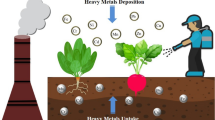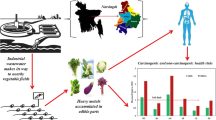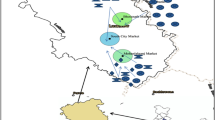Abstract
Heavy metal contamination of vegetables is a great public health concern. One hundred samples of spinach, dill, cilantro, and cress from the production sites of Shiraz, Iran, and its outskirts were, therefore, examined for lead (Pb), cadmium (Cd), copper (Cu), zinc (Zn), nickel (Ni), and cobalt (Co) content. The potential health risks of these metals to local residents via the consumption of leafy vegetables were also estimated. The mean concentrations of Pb, Cd, Cu, Zn, Ni, and Co were 3.21, 0.28, 4.55, 40.44, 3.11, and 1.86 mg/kg dry weight, respectively. The Pb level exceeded the permissible limit of 0.3 mg/kg in 44.7% of vegetable samples. The other elements were, however, within FAO/WHO standards. The estimated daily intake (EDI) of Pb, Cd, Cu, Zn, Ni, and Co from leafy vegetables was 0.10, 0.01, 0.14, 1.26, 0.10, and 0.06 μg/kg body weight/day, respectively. At the mean and 97.5 percentile levels, all health risk index (HRI) values were less than the safe limit (< 1). Thus, within the area this study was focused on, leafy vegetables did not make a major contribution to the dietary intake of the elements which could be mainly attributed to the low vegetable consumption by the study population (20 g/day). Nevertheless, the lead content of the vegetables should be viewed with some concern. Regular monitoring of heavy metal contamination of foodstuff is recommended to control the sources of contaminants in the food chain.
Similar content being viewed by others
References
Alam, M., Snow, E., & Tanaka, A. (2003). Arsenic and heavy metal contamination of vegetables grown in Samta village, Bangladesh. Science of the Total Environment, 308(1–3), 83–96.
Ali, M. H., & Al-Qahtani, K. M. (2012). Assessment of some heavy metals in vegetables, cereals and fruits in Saudi Arabian markets. The Egyptian Journal of Aquatic Research, 38(1), 31–37.
Bagdatlioglu, N., Nergiz, C., & Ergonul, P. G. (2010). Heavy metal levels in leafy vegetables and some selected fruits. Journal für Verbraucherschutz und Lebensmittelsicherheit, 5(3–4), 421–428.
Bahemuka, T., & Mubofu, E. B. (1999). Heavy metals in edible green vegetables grown along the sites of the Sinza and Msimbazi rivers in Dar Es Salaam, Tanzania. Food Chemistry, 66(1), 63–66.
Bigdeli, M., & Seilsepour, M. (2008). Investigation of metals accumulation in some vegetables irrigated with waste water in Shahre Rey-Iran and toxicological implications. American-Eurasian Journal of Agricultural & Environmental Sciences, 4(1), 86–92.
Bo, S., Mei, L., Tongbin, C., Zheng, Y., Yunfeng, X., Xiaoyan, L., et al. (2009). Assessing the health risk of heavy metals in vegetables to the general population in Beijing, China. Journal of Environmental Sciences, 21(12), 1702–1709.
Chang, C., Yu, H., Chen, J., Li, F., Zhang, H., & Liu, C. (2014). Accumulation of heavy metals in leaf vegetables from agricultural soils and associated potential health risks in the Pearl River Delta, South China. Environmental Monitoring and Assessment, 186(3), 1547–1560.
Chen, L., Zhou, S., Shi, Y., Wang, C., Li, B., Li, Y., & Wu, S. (2018). Heavy metals in food crops, soil, and water in the Lihe River watershed of the Taihu region and their potential health risks when ingested. Science of the Total Environment, 615, 141–149.
Codex Alimentarius Commission. (2001). Food additives and contaminants. ALINORM 01/12A (pp. 1–289). Geneva: Joint FAO/WHO Food Standards Programme.
Codex Alimentarius Commission. (2011). Working document for information and use in discussions related to contaminants and toxins in the GSCTFF. Rome: CODEX.
Dodd, J. L., & Bayerl, C. T. (2012). Behavioral-enviromental: the individual in the community. In L. K. Mahan, S. Escott-Stump, & J. L. Raymond (Eds.), Krause’s Food & the nutrition care process (pp. 229–247). St. Louis: Saunders Elsevier.
Dogheim, S., Ashraf, E. M., Alla, S. G., Khorshid, M., & Fahmy, S. (2004). Pesticides and heavy metals levels in Egyptian leafy vegetables and some aromatic medicinal plants. Food Additives and Contaminants, 21(4), 323–330.
Edelstein, M., & Ben-Hur, M. (2018). Heavy metals and metalloids: sources, risks and strategies to reduce their accumulation in horticultural crops. Scientia Horticulturae., 234, 431–444.
EFSA (European Food Safety Authority) Panel on Contaminants in the Food Chain (CONTAM). (2010). Scientific opinion on lead in food. EFSA Journal, 8(4), 1570 151 pp.
Eftekhari, M. H., Mazloomi, S. M., Akbarzadeh, M., & Ranjbar, M. (2014). Content of toxic and essential metals in recrystallized and washed table salt in Shiraz, Iran. Journal of Environmental Health Science and Engineering, 12(1), 10.
Elbagermi, M., Edwards, H., & Alajtal, A. (2012). Monitoring of heavy metal content in fruits and vegetables collected from production and market sites in the Misurata area of Libya. ISRN Analytical Chemistry, 2012, 1–5.
EVM (Expert Group on Vitamins and Minerals). (2003). Safe upper levels for vitamins and minerals. Food Standards Agency London. http://www.foodstandards.gov.uk/multimedia/pdfs/vitmin2003.pdf
FAO (Food and Agriculture Organization). (2015). FAO Statistical Pocketbook. Rome: FAO.
Finley, B. L., Monnot, A. D., Paustenbach, D. J., & Gaffney, S. H. (2012). Derivation of a chronic oral reference dose for cobalt. Regulatory Toxicology and Pharmacology, 64(3), 491–503.
Ghasemidehkordi, B., Malekirad, A. A., Nazem, H., Fazilati, M., Salavati, H., Shariatifar, N., Rezaei, M., Fakhri, Y., & Mousavi Khaneghah, A. (2018). Concentration of lead and mercury in collected vegetables and herbs from Markazi province, Iran: a non-carcinogenic risk assessment. Food and Chemical Toxicology, 113, 204–210.
Guerra, F., Trevizam, A. R., Muraoka, T., Marcante, N. C., & Canniatti-Brazaca, S. G. (2012). Heavy metals in vegetables and potential risk for human health. Scientia Agricola, 69(1), 54–60.
Hu, J., Wu, F., Wu, S., Cao, Z., Lin, X., & Wong, M. H. (2013). Bioaccessibility, dietary exposure and human risk assessment of heavy metals from market vegetables in Hong Kong revealed with an in vitro gastrointestinal model. Chemosphere, 91(4), 455–461.
Huang, Z., Pan, X.-D., Wu, P.-G., Han, J.-L., & Chen, Q. (2014). Heavy metals in vegetables and the health risk to population in Zhejiang, China. Food Control, 36(1), 248–252.
ISIRI (Institute of Standards and Industrial Research of Iran). (2011). Food & feed-maximum limit of heavy metals. Iranian National Standard 12968 (1st revision). Karaj: ISIRI.
Jafarian-Dehkordi, A., & Alehashem, M. (2013). Heavy metal contamination of vegetables in Isfahan, Iran. Research in Pharmaceutical Sciences, 8(1), 51–58.
JECFA (Joint FAO/WHO Expert Committee on Food Additives). (2010). Evaluation of certain food additives and contaminants: 73ed report of the Joint FAO/WHO Expert Committee on Food Additives. WHO Technical Report Series 960.
Kachenko, A. G., & Singh, B. (2006). Heavy metals contamination in vegetables grown in urban and metal smelter contaminated sites in Australia. Water, Air, and Soil Pollution, 169(1–4), 101–123.
Khan, S., Rehman, S., Khan, A. Z., Khan, M. A., & Shah, M. T. (2010). Soil and vegetables enrichment with heavy metals from geological sources in Gilgit, northern Pakistan. Ecotoxicology and Environmental Safety, 73(7), 1820–1827.
Khan, M. U., Malik, R. N., & Muhammad, S. (2013). Human health risk from heavy metal via food crops consumption with wastewater irrigation practices in Pakistan. Chemosphere, 93(10), 2230–2238.
Marvin, H. J., Kleter, G. A., Noordam, M. Y., Franz, E., Willems, D. J., & Boxall, A. (2013). Proactive systems for early warning of potential impacts of natural disasters on food safety: climate-change-induced extreme events as case in point. Food Control, 34(2), 444–456.
Metrohm Application Bulletin No. 113/2e. (2000). Determination of cadmium, lead and copper in foodstuffs, Waste water and sewage sludge by anodic stripping voltammetry after digestion.
Nagajyoti, P., Lee, K., & Sreekanth, T. (2010). Heavy metals, occurrence and toxicity for plants: a review. Environmental Chemistry Letters, 8(3), 199–216.
Radwan, M. A., & Salama, A. K. (2006). Market basket survey for some heavy metals in Egyptian fruits and vegetables. Food and Chemical Toxicology, 44(8), 1273–1278.
Rahmdel, S., Abdollahzadeh, S. M., Mazloomi, S. M., & Babajafari, S. (2015). Daily dietary intakes of zinc, copper, lead, and cadmium as determined by duplicate portion sampling combined with either instrumental analysis or the use of food composition tables, Shiraz, Iran. Environmental Monitoring and Assessment, 187(5), 349.
Salehipour, M., Ghorbani, H., Kheirabadi, H., & Afyuni, M. (2015). Health risks from heavy metals via consumption of cereals and vegetables in Isfahan Province, Iran. Human and Ecological Risk Assessment: An International Journal, 21(7), 1920–1935.
Sharma, B., & Chhetri, M. (2005). Monitoring of heavy metals in vegetables and soil of agricultural fields of Kathmandu Valley. Ecoprint: An International Journal of Ecology, 12, 1–9.
Sharma, R. K., Agrawal, M., & Marshall, F. M. (2008). Heavy metal (Cu, Zn, Cd and Pb) contamination of vegetables in urban India: A case study in Varanasi. Environmental Pollution, 154(2), 254–263.
Sharma, R. K., Agrawal, M., & Marshall, F. M. (2009). Heavy metals in vegetables collected from production and market sites of a tropical urban area of India. Food and Chemical Toxicology, 47(3), 583–591.
Singh, A., Sharma, R. K., Agrawal, M., & Marshall, F. M. (2010). Health risk assessment of heavy metals via dietary intake of foodstuffs from the wastewater irrigated site of a dry tropical area of India. Food and Chemical Toxicology, 48(2), 611–619.
Souri, M. K., Alipanahi, N., Hatamian, M., Ahmadi, M., & Tesfamariam, T. (2018). Elemental profile of heavy metals in garden cress, coriander, lettuce and spinach, commonly cultivated in Kahrizak, south of Tehran-Iran. Open Agriculture, 3(1), 32–37.
Stalikas, C., Mantalovas, A. C., & Pilidis, G. (1997). Multielement concentrations in vegetable species grown in two typical agricultural areas of Greece. Science of the Total Environment, 206(1), 17–24.
Taghipour, H., & Mosaferi, M. (2013). Heavy metals in the vegetables collected from production sites. Health Promotion Perspectives, 3(2), 185–193.
The US Food and Nutrition Board. (2001). Dietary reference intakes for vitamin A, vitamin K, arsenic, boron, chromium, copper, iodine, iron, manganese, molybdenum, nickel, silicon, vanadium, and zinc. Institute of Medicine-Washington (DC): National Academy Press.
Tom, M., Fletcher, T. D., & McCarthy, D. T. (2014). Heavy metal contamination of vegetables irrigated by urban stormwater: a matter of time? PLoS One, 9(11), e112441.
Wang, X., Sato, T., Xing, B., & Tao, S. (2005). Health risks of heavy metals to the general public in Tianjin, China via consumption of vegetables and fish. Science of the Total Environment, 350(1–3), 28–37.
Yang, Q.-W., Xu, Y., Liu, S.-J., He, J.-F., & Long, F.-Y. (2011). Concentration and potential health risk of heavy metals in market vegetables in Chongqing, China. Ecotoxicology and Environmental Safety, 74(6), 1664–1669.
Zheng, N., Wang, Q., & Zheng, D. (2007). Health risk of Hg, Pb, Cd, Zn, and Cu to the inhabitants around Huludao Zinc Plant in China via consumption of vegetables. Science of the Total Environment, 383(1–3), 81–89.
Funding
This study was financially supported by Shiraz University of Medical Sciences (project no. 90-01-42-3117).
Author information
Authors and Affiliations
Corresponding author
Ethics declarations
Conflict of interest
The authors declare that they have no conflict of interest.
Rights and permissions
About this article
Cite this article
Rahmdel, S., Rezaei, M., Ekhlasi, J. et al. Heavy metals (Pb, Cd, Cu, Zn, Ni, Co) in leafy vegetables collected from production sites: their potential health risk to the general population in Shiraz, Iran. Environ Monit Assess 190, 650 (2018). https://doi.org/10.1007/s10661-018-7042-3
Received:
Accepted:
Published:
DOI: https://doi.org/10.1007/s10661-018-7042-3




